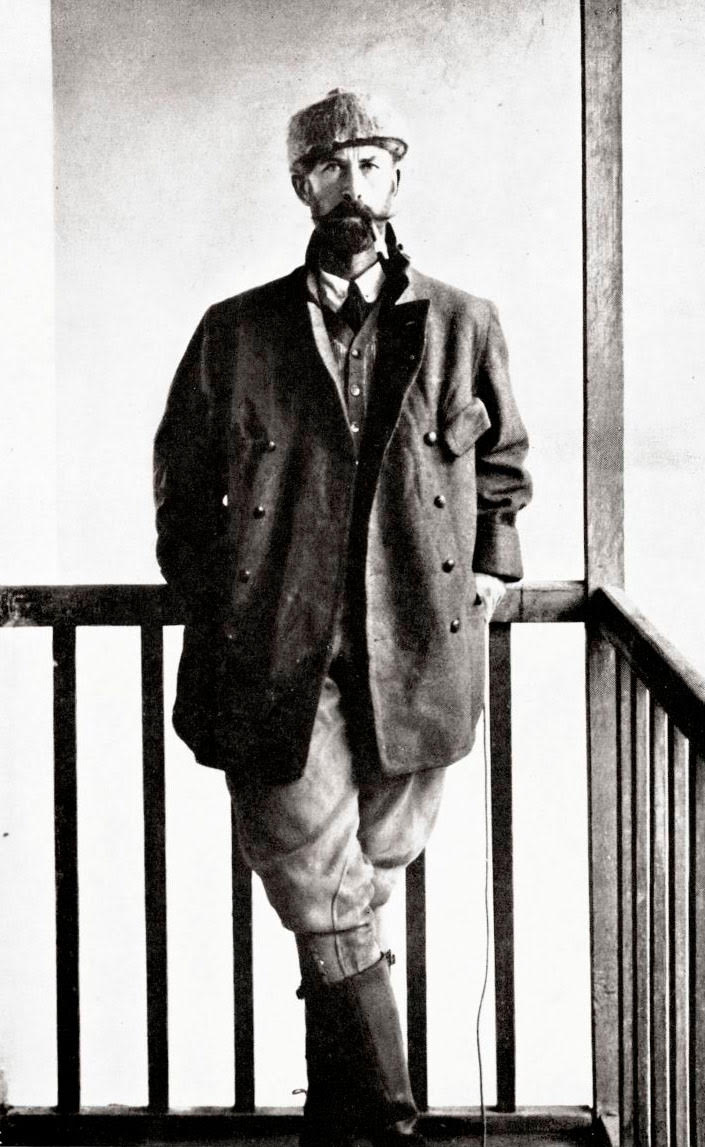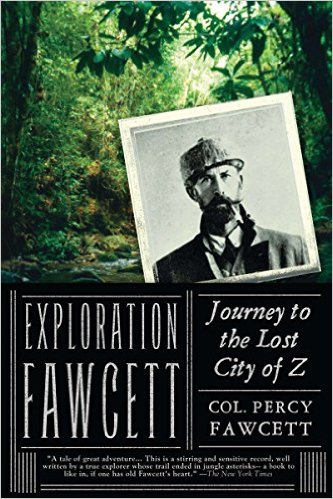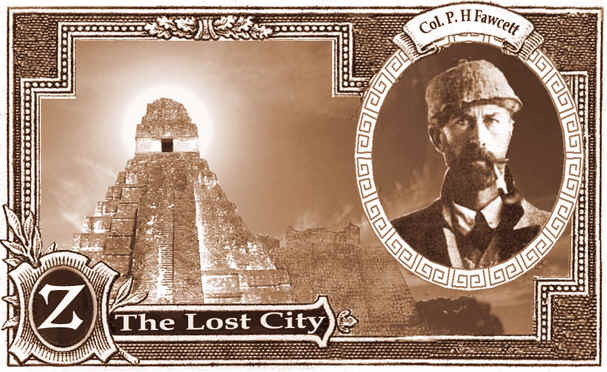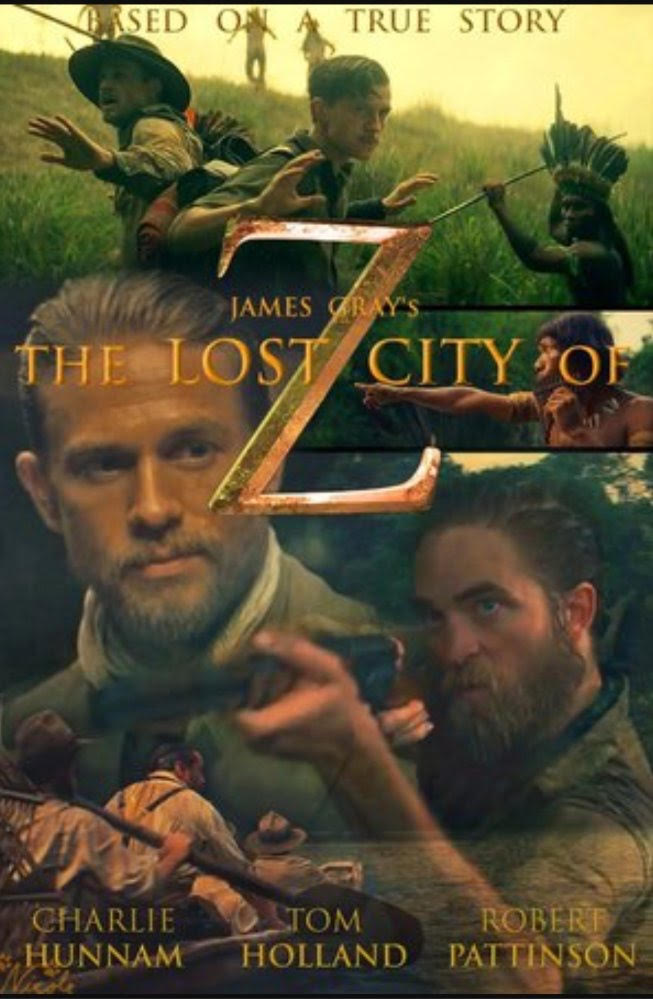PERCY FAWCETT: 1867 – 1925* (*Exact year of death unknown)
Colonel Percy Fawcett was one of the most enigmatic, colourful and adventurous characters of the entire 20th century, let alone the history of Spike Island, and the 3 years he would spend on Spike Island were just part of a rich life lived with a real zest for exploration and achievement.
 Fawcett was a man of many talents and he would find work during his life as a British spy, a noted surveyor, a geographer, a jungle adventurer and a celebrated writer. Famous within his own lifetime he would become friends with literary giants H.R Hagard of ‘Kings Solomon’s mines’ fame, and ‘Sherlock Holmes’ creator Arthur Conan Doyle who would write his best selling ‘The lost World’ book based on Fawcetts accounts of his journeys in unexplored South America. His fame lasts til this day, and In 2017 a Hollywood movie called ‘The lost city of Z’ was released by Brad Pitts production company, starring Robert Pattinson of ‘Twilight’ fame, Tom Holland as Fawcett’s son Jack, Sienna Miller as his wife Nina and Charlie Hunnam as Percy Fawcett himself. The film retells his life as relayed from his own best selling journals and his surviving sons account of his life in the book ‘Exploration Fawcett’.
Fawcett was a man of many talents and he would find work during his life as a British spy, a noted surveyor, a geographer, a jungle adventurer and a celebrated writer. Famous within his own lifetime he would become friends with literary giants H.R Hagard of ‘Kings Solomon’s mines’ fame, and ‘Sherlock Holmes’ creator Arthur Conan Doyle who would write his best selling ‘The lost World’ book based on Fawcetts accounts of his journeys in unexplored South America. His fame lasts til this day, and In 2017 a Hollywood movie called ‘The lost city of Z’ was released by Brad Pitts production company, starring Robert Pattinson of ‘Twilight’ fame, Tom Holland as Fawcett’s son Jack, Sienna Miller as his wife Nina and Charlie Hunnam as Percy Fawcett himself. The film retells his life as relayed from his own best selling journals and his surviving sons account of his life in the book ‘Exploration Fawcett’.
 Fawcett started life in Torquay and joined the royal artillery corps in 1886. He would be sent to Ceylon, modern day Sri Lanka and there he would meet his wife and lifetime partner Nina, who was born to a wealthy family who sent her to Scotland to be educated before a return to Ceylon. They met at a tennis party in Fort Galle, hitting it off instantly and falling deeply for one another. Fawcett soon proposed to the girl considered to be the prettiest in all of Sri Lanka, but his mischievous brother and sisters, driven by jealously presumably, falsely told him that Nina was ‘far from a virgin’. He wrote to her saying ‘you are not the pure young girl I thought you to be’ and the engagement was promptly called off. Nina would soon marry a Captain Herbert Prichard and she was taken to live in Alexandria to live a reluctant life. But her husband would die soon of Anthrax and clearly the man knew the heart of his wife, for his last words to her were reported to be “Go….and marry Fawcett. He is the real man for you”. High Victorian drama indeed!
Fawcett started life in Torquay and joined the royal artillery corps in 1886. He would be sent to Ceylon, modern day Sri Lanka and there he would meet his wife and lifetime partner Nina, who was born to a wealthy family who sent her to Scotland to be educated before a return to Ceylon. They met at a tennis party in Fort Galle, hitting it off instantly and falling deeply for one another. Fawcett soon proposed to the girl considered to be the prettiest in all of Sri Lanka, but his mischievous brother and sisters, driven by jealously presumably, falsely told him that Nina was ‘far from a virgin’. He wrote to her saying ‘you are not the pure young girl I thought you to be’ and the engagement was promptly called off. Nina would soon marry a Captain Herbert Prichard and she was taken to live in Alexandria to live a reluctant life. But her husband would die soon of Anthrax and clearly the man knew the heart of his wife, for his last words to her were reported to be “Go….and marry Fawcett. He is the real man for you”. High Victorian drama indeed!
Fawcett, having discovered the nasty ploy of his family begged Nina for forgiveness and they were soon married. He would call her ‘Cheeky’ and she would name him ‘Puggy’ as they enjoyed a happy life together in the beautiful Sri Lankan countryside. They soon had a son and named him Jack.
Fawcett would work in North Africa for the British secret service, a role that no doubt appealed to his thrist for adventure. It was in 1903 that Fawcett was sent to work on Spike Island, Cork, by the war office, uprooting the family initially but they would soon find a peace and comfort on Spike Island that Fawcett would miss on occasions when deep inside the jungles of South America. As a high ranking officer while on the island it was a position of comfort for Fawcett who engaged in the finer activities of the age. During his time on Spike Island he also entertained his interest in the occult, holding seances on the island to communicate with the dead. It was over a decade later during a seance that he was gripped by an idea.
 He long burned a candle for the adventurous life and when the opportunity came to go to Bolivia to work as the chief survey commissioner he could not refuse. He left in 1906 and it was to be the first of several journeys that involved exploring previously untouched rainforests and rivers to assist in mapmaking and border disputes. He would often encounter incredibly dangerous working towns, where the booming rubber industry drove men to find their fortune, despite the terrible conditions they endured. Some of these town reported death rates of 40% a year, from disease and murder! If the European emigrants weren’t already dangerous enough the local Amazonian tribes offered plenty of distraction, and he often found himself avoiding poisoned darts and arrows as he went about his work charting the deep jungle. While much of this work was for practical ends, Fawcett was driven by the idea of finding something much less run of the mill than mere map making. He was interested in finding one of the fabled ‘lost cities’ of South America, and he put much research into their existence and possible locations.
He long burned a candle for the adventurous life and when the opportunity came to go to Bolivia to work as the chief survey commissioner he could not refuse. He left in 1906 and it was to be the first of several journeys that involved exploring previously untouched rainforests and rivers to assist in mapmaking and border disputes. He would often encounter incredibly dangerous working towns, where the booming rubber industry drove men to find their fortune, despite the terrible conditions they endured. Some of these town reported death rates of 40% a year, from disease and murder! If the European emigrants weren’t already dangerous enough the local Amazonian tribes offered plenty of distraction, and he often found himself avoiding poisoned darts and arrows as he went about his work charting the deep jungle. While much of this work was for practical ends, Fawcett was driven by the idea of finding something much less run of the mill than mere map making. He was interested in finding one of the fabled ‘lost cities’ of South America, and he put much research into their existence and possible locations.
Based on his documentary research, Fawcett had by 1914 formulated ideas about a “lost city” he named “Z”, located somewhere in the Mato Grosso region of Brazil. He theorized that a complex civilization once existed in the Amazon and that isolated ruins of a large city may survive. Fawcett also found a document known as Manuscript 512, written after explorations made in the sertão of the province of Bahia, and housed at the National Library of Rio de Janeiro. It is believed to be by Portuguese bandeirante João da Silva Guimarães, who wrote that during 1753 he’d discovered the ruins of an ancient city that contained arches, statues and a temple with strange hieroglyphics. The city was described in great detail without providing a specific location. This city became a secondary destination for Fawcett, after “Z”, and by now the quest consumed him and his thoughts. Map mapking was no longer enough, he wanted to focus on his lost civilisation theory. He tried to gain funding from his fellows at the royal societies but many mocked him for searching for what they saw as a myth, ‘the lost city of gold’.
Fawcett served with distinction in World War 1, commanding men and surviving the front. It was during this time he conducted a seance to speak to the dead souls of men who had lived in the South America region he was so desperate to return too. He became even more convinced, almost fanatical, that his lost city awaited him.
Fawcett mede as many as 8 trips to the region from the early 1900’s to 1920, and would return to see his wife and family each time and share his discoveries. He would not be long back in Britain where Nina had now relocated to from Spike Island before he would be restless and consumed again. Each time he ventured deeper into the unknown, to areas where no European had ever set foot before. He did encounter many signs that led him to beleive he was on the right path, which included what appeared to be roads, stairs and markings deep within the jungle where supposedly no humans had ever been before. The discovery of Machu Picchu in Peru in 1911 proved for many that Fawcett was exactly right, that great civilisations did exist in the jungles of South America, which is now a well established fact. The discovery of the lost city high in the mountains of Peru did not deter Fawcett who remained convinced that this was not his lost city of Z, just a similar site.
It was in 1925 with funding from a London-based group of financiers known as the Glove that Fawcett returned to Brazil with his elder son Jack and Jack’s friend, for an exploratory expedition to find “Z”. Fawcett left instructions stating that if the expedition did not return, no rescue expedition should be sent lest the rescuers suffer his fate.
 Fawcett was a man with years of experience travelling, and had brought equipment such as canned foods, powdered milk, guns, flares, a sextant, and a chronometer. His travel companions were both chosen for their health, ability and loyalty to each other—- his eldest son Jack Fawcett and Jack’s long-time friend Raleigh Rimell. Fawcett chose only two companions in order to travel lighter and be less noticeable to the native tribes, as he knew many remained hostile towards Europeans who had decimated much of their numbers.
Fawcett was a man with years of experience travelling, and had brought equipment such as canned foods, powdered milk, guns, flares, a sextant, and a chronometer. His travel companions were both chosen for their health, ability and loyalty to each other—- his eldest son Jack Fawcett and Jack’s long-time friend Raleigh Rimell. Fawcett chose only two companions in order to travel lighter and be less noticeable to the native tribes, as he knew many remained hostile towards Europeans who had decimated much of their numbers.
On 20 April 1925 his final expedition departed from Cuiabá. In addition to his two principal companions, Fawcett was accompanied by two Brazilian labourers, two horses, eight mules, and a pair of dogs. The last communication from the expedition was on 29 May 1925, when Fawcett wrote a letter to his Nina to say that he was ready to go into unexplored territory with only Jack and Rimell, which was delivered by a native runner. They were reported to be crossing the Upper Xingu, a southeastern tributary river of the River Amazon. The final letter, written from Dead Horse Camp, gave their location and was generally optimistic. But it was to be the last word from the explorer.
When there was no word for many months the grim reality had to be accepted. The quest had taken his life, and that of his companions. Many people assumed that local Indians had killed them, as several tribes were nearby at the time: the Kalapalos, the last tribe to have seen them, the Arumás, Suyás, and the Xavantes whose territory they were entering. Both of the younger men were lame and ill when last seen, and it would have been common for trespassers to be killed by tribes if captured. It is plausible that they died of natural causes in the Brazilian jungle, but no one can say to this day.
Despite his earlier appeal for noone to search for them, several rescue efforts were sent after the 3 man team. During 1927 one such expedition found a name-plate of Fawcett with an Indian tribe. During June 1933, a theodolite compass belonging to Fawcett was found near a site owned by the Baciary Indians of Mato Grosso, by a Colonel Aniceto Botelho. However the name-plate was from Fawcett’s expedition five years earlier and had most likely been given as a gift to the chief of that Indian tribe. The compass was proved to have been left behind before he entered the jungle on his final journey. So for all the rescue efforts there could be no certainty of how the group had met their demise.
During the decades ensuing, various groups mounted several rescue expeditions, without success. They heard only various rumours that could not be verified. In addition to reports that Fawcett had been killed by Indians or wild animals, there was a tale that Fawcett had lost his memory and lived out his life as the chief of a tribe of cannibals.
An incredible estimated 100 would-be-rescuers died on several expeditions attempting to discover Fawcett’s fate, showing the dangers of the region. One of the earliest was commanded by American explorer George Miller Dyott during 1927; he claimed to have found evidence of Fawcett’s death by the Aloique Indians, but his story was unconvincing. During 1930-31, Aloha Wanderwell used her seaplane to try to find him. A 1951 expedition unearthed human bones that were found later to be unrelated to Fawcett or his companions.
Danish explorer Arne Falk-Rønne journeyed to the Mato Grosso during the 1960s. In a 1991 book he wrote that he learned of Fawcett’s fate from Orlando Villas-Bôas, who had heard it from one of Fawcett’s murderers. Allegedly, Fawcett and his companions had a mishap on the river and lost most of the gifts they’d brought along for the Indian tribes. Continuing without gifts was a serious breach of protocol; since the expedition members were all more or less seriously ill at the time, the Kalapalo tribe they encountered decided to kill them. The bodies of Jack Fawcett and Raleigh Rimell were thrown into the river; Colonel Fawcett, considered an old man and therefore distinguished, received a proper burial. Falk-Rønne visited the Kalapalo tribe and reported that one of the tribesmen confirmed Villas-Bôas’s story about how and why Fawcett had been killed.
But in truth no one can say what happened to the 20th century’s greatest explorer. His wife Nina would move with Fawcetts remaining son to Jamaica, away from the press hysteria surrounding his disappearance. The British society would continue to send missions enquiring as to his disappearance as late as the 1980’s, but to no avail. The man who tried to solve some of South Americas great mysteries became one himself.
Today we celebrate the life of our famous former resident by retelling his story on our fully guided tours, with future exhibitions planned in his honour. He was recently named in ‘Lonely Planet’s’ list of greatest explorers of all time, and movies and books in his name continue to be published. George Lucas is rumoured to have used him as the inspiration for his ‘Indiana Jones’ character, so his spirit of adventure lives on in the people he inspired.

